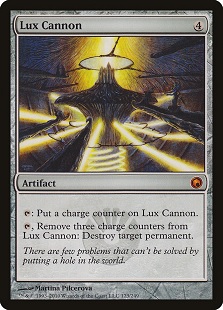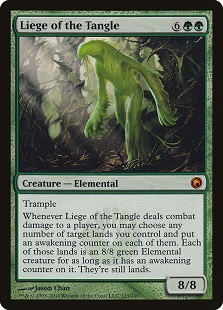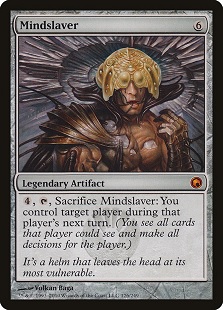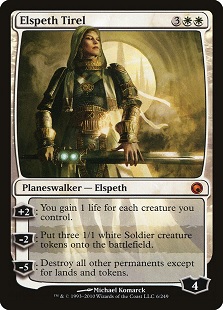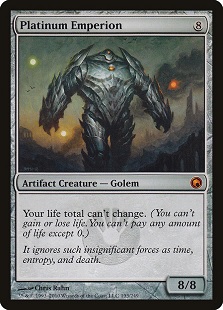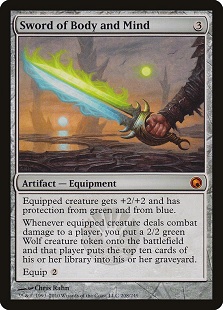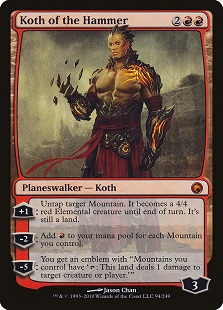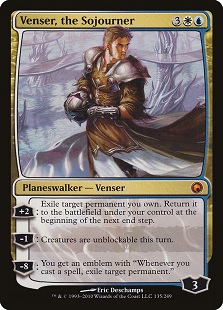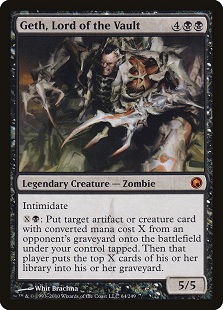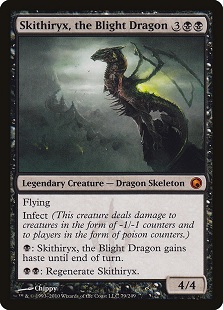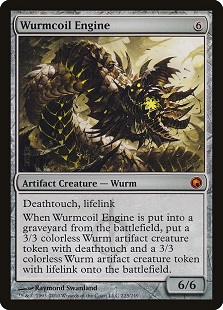Mirrodin was an extremely formative set for myself and many players. I had been playing for a few years before then, but Mirrodin felt like the set where I really started to come into my own as a player. I was going to tournaments, reading the novels, and engaging with the game more than I ever had previously. As such, it was really special coming back to the game after a couple year hiatus and finding that one of the first sets on my return was Scars of Mirrodin and not only did it feature one of my favorite planes but also one of the most legendary villains in all of Magic: the Phyrexians.
This set is near and dear to my heart for many reasons and one such reason is the many mythics of the set. Today I'm going to be going through them all and ranking each one as we go along. There's fifteen great cards to cover here so let's jump in and check them out! Just be mindful of the glistening oil as you get through it.
15. Quicksilver Gargantuan
When Onslaught came out, the reprinting of Clone was seen as a really big deal. Wizards stopped printing clones due to issues they presented in the rules until they finally found a solve for those issues. As such, over the course of the years that followed, we saw tons of new clone variants come out. Some were good, others less so. Quicksilver Gargantuan lands on the latter side of things, as a four-mana Clone wasn't super great on its own and a seven-mana one is even less so. Many creatures you'll be trying to copy will naturally be 7/7s or close to it anyways for way less mana, making this dreadfully unenjoyable to play over the majority of other clones in the game.
14. Molten-Tail Masticore
If you're of a certain age, chances are you'll remember how unbeatable and powerful the original Masticore card was. It's almost legendary in its might for the era and as such is repeatedly referenced in sets over the years. One such card was Molten-Tail Masticore - a continua-tion of Mirrodin-based Masticores that began with Razorfang Masticore in Fifth Dawn. In some ways I think you could argue that this one's even better, largely be-ing the same card except the ability deals more damage. However, requiring you to exile cards and costing a minimum of 4 mana to activate is a lot more rough than just paying two for one damage with no drawback. Masticore may have been king in its own time, but over a decade later it simply isn't able to cut it any longer.
13. Lux Cannon
Blowing up anything you want absolutely rocks. I think just about every player wants to be able to do that. What players don't want to do, however, is wait four turns (without help) each time to do it. There's some genuine degree of cool factor here compared to the previous two cards, but it's too clunky to be useful in most circumstances.
12. Liege of the Tangle
You simply haven't lived until you've hit someone with a Liege of the Tangle and then turned several of your lands into giant creatures. Seriously, this thing hits like an absolute truck and then makes you harder to beat in the process. The big problem is the high mana cost and how it makes your lands vulnerable to a board wipe. It's as Timmy/Tammy of a card as it gets, though, so while it's a little on the boring side to use, casuals are sure to love the hell out of it.
11. Mindslaver
When Mindslaver first came out, it was, for lack of a better term, mind blowing. The card was so novel when it first came out, there needed to be a whole section added to the comprehensive rulebook. As time went on, players realized that for as awesome as it was, it was generally too expen-sive to make work, though that wouldn't stop players from trying to find ways to make it work. By the time Scars of Mirrodin rolled around, it was seen as an awesome nod to the cooler and less broken aspects of the original Mirrodin, but it was way less exciting and lacked any real value as a result. In spite of this, it's hard to deny just how iconic of a card this was - and is - and how it's the epitome of a mythic with real wow factor behind it. It just wasn't as good the second time around.
10. Indomitable Archangel
Indomitable Archangel is the epitome of a card that's utterly boring to read, but plays outstandingly in the decks that want it. If you can turn it into an artifact itself - say with Mycosynth Lattice or Memnarch, for example - it makes it hard to touch any of your stuff at all. It's very narrow in its uses, but it's about as much of a cornerstone as you can get in artifact-based Commander decks and for that reason alone it deserves a spot here.
9. Elspeth Tirel
Personally, I'd put Elspeth Tirel among the worst of the Elspeth planeswalker cards out there. She doesn't get you as many tokens as you'd expect from an Elspeth card, and her life gain isn't impactful enough on its own since she can just be attacked after. The ultimate is great if you can pull it off, but it requires a lot of work to make it happen. If you can use other things to defend her, though, she can really put in some solid work - especially alongside other Elspeth cards since the rules change surrounding planeswalkers. She may be a B as far as Elspeths go, but a B is still great.
8. Platinum Emperion
I've covered Platinum Angel twice now in my mythic ranking articles and as such I've talked about how legendary of a card it was at the time. On a return to Mirrodin, Wizards tried to catch that same lightning in a bottle twice by giving us a new take on the concept, making it so you effective-ly can't lose the game - at least by life loss. It cost a lot more mana to cast, but it was also a lot bigger at the same time. Still, it made a big impact and found itself to be a popular card for Commander and - surprisingly - Constructed formats, despite Platinum Angel not seeing play in those same formats.
7. Sword of Body and Mind
It was seriously awesome seeing the Swords of X and Y come back following the two classic ones in Darksteel. This one wouldn't have quite the reach and power of the other ones, but what it excelled in was getting players excited at the possibilities for what else could be waiting in the wings. This sword never saw too much play in Constructed, however it's a truly dominant force in Limited giv-en the low deck size. It often doesn't take more than two good hits with this to completely devastate opponents, and even today it's still one of the best things you can be doing in Cube.
6. Koth of the Hammer
You might not think it today, but at the time Koth was the chase card of Scars of Mirrodin. I'm not exaggerating either, as it would go for about $30-40 with the next most expensive card generally being Mox Opal at $20. These days the card doesn't see much play outside of Cubes and Mono-Red Commander decks, but at the time it was a key card to many Mono-Red Aggro decks in Standard. As such, it commanded a hefty price tag for those wanting to beat opponents' faces in fast. He's not super exciting today, but you have to respect him for just how good he was in his era.
5. Venser, the Sojourner
Venser, on the other hand, has only appreciated in utility as the years have gone on. Players love a good Blink deck and Venser, the Sojourner fits the bill there perfectly for that sort of strategy. Basically pair him up with the best value creatures you can find and go to town, and if you can ultimate him you'll often just win the game in record time. He's outstanding in Commander, and has plenty of uses in Cubes as well, making for a really well-rounded planeswalker that never feels too op-pressive to play against.
4. Geth, Lord of the Vault
I opened so many Geths back when Scars was the newest set and I couldn't believe how the card was bulk for so long. I played the card in just about every deck I could, because the ability was just so strong. Getting to steal cards out of opponents' graveyards has always felt awesome and it feels even better when you mill them for more fuel to do it again later. Geth went up in price for a while but is back down to bulk prices thanks to multiple reprints, which is great because if you're play-ing Black in Commander, you should definitely think about trying to find a slot for this card. It's that much of a house.
3. Skithiryx, the Blight Dragon
Similar to Geth, if you wanted a really potent Mono-Black Commander card, you ran Skithiryx all day, every day. The card never saw much Constructed play outside of a handful of Mono-Black decks in Standard, but it became a truly dominating force in good old Elder Dragon Highlander. Who cares if you start off at 40 life when all it takes to kill you is 10 poison counters? Oftentimes you'd simply play ol' Skittles, suit it up with some equipment (like Strata Scythe for massive beats), and wipe opponents out fast one at a time. It was so powerful it raised a number of discussions on whether or not poison should be treated differently in Commander, but as time has gone on, it remains the same it did back then, meaning the Blight Dragon can still wreak havoc on casual pods the world over.
2. Wurmcoil Engine
I can't think of many cards quite as ubiquitous as Wurmcoil Engine. It was a house in Standard, has seen play in plenty of non-rotating formats, and is a staple of Cubes and Commander alike. It's just extremely good and efficient at what it does and that's all it needs to be. A 6/6 death-touch and lifelinker for 6 mana is great enough on its own, but the fact that it goes in any deck and gives you even more value when it dies just sends it into the stratosphere of playability. An absolute classic in every sense of the word.
1. Mox Opal
The Moxen are often fairly innocuous cards. In many cases, you'll likely find yourself wondering how they could be good or how you could make them work for you. I certainly remember finding myself scratching my head trying to think how you could actually make Mox Diamond and Chrome Mox work effectively for you. Many players wrote off Mox Amber for a long time until people found out ways to use that and look where it is now.
Mox Opal was actually in somewhat of a similar boat at the time. There weren't really very many artifact-heavy decks so you mostly ran it only in Tempered Steel decks. It had some obvious play in other formats early on as well, such as Affinity in Legacy and soon in Modern, but the greater uses were initially minimal. Over time, though, the card found its way into many, many decks in Modern, playing key roles in not just Affinity but also Krark-Clan Ironworks Com-bo and Urza Thoptersword decks. This would lead to Mox Opal eventually being banned in the format, cementing it as a clear powerhouse for all time.
Paige Smith
Twitter: @TheMaverickGal
Twitch: twitch.tv/themaverickgirl
YouTube: TheMaverickGal


















